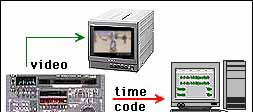|
Picture Process
|
. |
Sound Process
|
| . |
 |
The sync sound recordings must now be transferd on the longitudinal audio tracks
(A1 et A2) of the video transfer tape, so that the picture
editor can move on with his work.
To do so, the analog outputs (stereo) of the DtD are connected to the A1 and
A2 inputs of the VTR. I recommend you use the Dolby NR function of the VTR to make
the sound a little better (it's a type C noise reduction system). |
|


|
| |
|
|
|
| |
| An IN point is programmed on the VTR, a few frames before the first sound element
to be recorded. The edit mode should be INSERT + A1 and A2 (in
ASSEMBLE mode, you'd wipe out the video !!!) |
|

|
| |
view of the edit mode selector
|
|
| |
All you have to do now is press the EDIT button
on the VTR. The machine will perform a pre-roll (rewind approximately
5 to 10 seconds), then go to plaback mode. the DtD will then lock to
the incoming time code, therefore in sync with the pictures. At the IN point time
code, the VTR will go to record mode on the two longitudinal audio tracks.
If you'd checked your recording levels before the transfer, you can now go
for some coffey while the sounds record themselves onto the video tape. |
|
|
NOTE : You're supposed to record a 1 kHz sine at 0 VU on the audio channels
during the color bars at the beginning of the tape so that the picture editor can
align his equipment, or simply as a reference for any future application from that
tape.
It's child's play to generate a 1 kHz sine wave from the DtD, and to set its playback
level so that it matches 0 VU on the VTR.
The problem is that this 1 kHz had better also reflect the RMS level of your sync
sound, so that it two, can be correctly recorded. Since the dB FS * value
to which the 0 VU corresponds is arbitrary in the digital world, all I can do is
give you an average value, a value that should work most of the time.
| |
* |
Full Scale : the negative scale typical of the digital world. It is
scaled in negative, from 0 downwards, because it is the highest possible electrical
level the A-->D or D-->A convernters can represent.. |
If you generate your 1 kHz between -8 and -14 FS from the DtD, so
that it drives the VTR at 0VU, everything should go fine during the subsequent audio
recordings. Indeed : most of the motion picture live sound recordings are very dynamic.
If the peaks have been recorded at 0 dB FS on the DtD (which should
be the case), the average level (RMS) of the signal
should hover between -8 and maybe -20 FS in worst cases.
|
 |
The picture editor can at last get the video tape(s) back to start working on
the editing. Since several days, or even weeks, can go by before his work can in
return be used by the sound editor (the sync sound will have been manipulated along
with the pictures and will therefore have changed positions !), what to do with
a DtD hard disk filled with hours of sound ?
The ideal solution is the removeable hard disk drive. I am against the
use of hard disks for long term memory applications (more than a few months) but
here, since the manipulation time window is rather short, they really are perfect.
The session (all the sync sounds that have been resynchronized and the wild tracks)
can entirely be contained on a set of disks (maybe even one big one) and set aside
while you work on other projects.
Ideal solution n°2 : a backup on MO disks.
Let's admit you don't have a removeable hard disk drive (poor bastard
!!!).
then you have to "empty" the content of the DtD's disk drive
to a medium capable of recording audio and time codeb at the same time. Since
you've painfully managed to resynchronize the sound with the time code of the video
transfer tapes, it would be a pity to lose all these time code relations once again.
|
| |
What you need for that is a time-code stereo recorder (or a multi-channel
one, if the sync sound had been recorded in such a format). And if possible, to avoid
unnecessary conversions, prefer a digital recorder. It can very well be an
analog recorder, like a 1/4" central time-code recorder for example, but the
sound would go through two conversion stages : D-->A and, later on, A-->D...
Not really what we're looking for nowadays !
This machine will record the digital output of your DtD as well as the painstakingly
found time code adresses. This medium will later on enable the "re-loading"
of the DtD's hard disk drive with the audio and its time code adresses, as if nothing
happened, as if you'd stayed on the same project in the meantime.
Note that both the sync sound transfer to the video tape and the "emptying"
of the hard disk drive to the "backup media" can be done simultaneously.
(see drawing on right) |
|

 |
| |
|
|
|
| |
The medium obtained here should be called "autoconform medium".
As it is most of the time a DAT tape (yuuuck !!!), they are
therefore often named "autoconform DATs". |
|